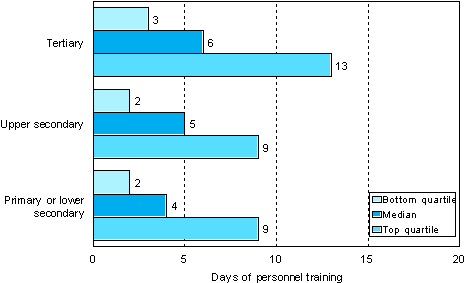Published: 31 December 2008
Average number of days of adult education and training is eight
In 2006 some 1.7 million Finnish residents, or nearly every second person aged 18 to 64, participated in adult education and training. One-half of the participants had received at least eight days of education and training (median).
Women were more active in participating in adult education and training, and they also received more days of it. The median of the study days was nine for women and under seven for men.
These data are based on the Finnish Adult Education Survey 2006 carried out jointly by Statistics Finland, the Ministry of Education and Eurostat. For this survey a total of 4,370 persons aged 18 to 64 were interviewed in February-June of 2006.
Figure 1. Number of days of personnel training per participant by highest level of educational attainment in 2006 (employees aged 18 to 64 and participating in training)

For the purpose of calculating the median and the top and
bottom quartiles, the data are ordered by magnitude in terms of
days in training.
Median represents the middle value in the data.
Bottom quartile represents the value under which 25 per cent of the
observations fall.
Top quartile represents the value under which 75 per cent of the
observations fall.
Five days of personnel training per year, on average
Nearly 60 per cent of the employees, or a total of 1.1 million persons, participated in education and training subsidised by the employer in 2006. Women received more such personnel training than men, but the amount of training received did not vary by gender. In 2006 employees who had participated in education and training received an average of five days of education and training subsidised by the employer.
With regard to age, no real differences were observed in the number of days of education and training subsidised by the employer. Upper white-collar employees and persons with tertiary level education received the highest numbers of days of personnel training. In 2006, persons classified as upper white-collar employees received on average 7 days, lower white-collar employees received 5 days and employees classified as blue-collar workers and participating in personnel training received roughly 3 days of education and training subsidised by the employer (median). Every second employee with tertiary level education who participated in personnel training received at least six days of personnel training, whereas the corresponding number for persons with upper secondary level education was five and for persons with primary or lower secondary level education four days (median, Figure 1).
The number of received days of personnel training has remained roughly on level with the year 2000.
Contents of adult education and training
The most common subjects of adult education and training in 2006 were associated with the fields of economics and law as well as services, safety and hobbies. Roughly one-third of the 18 to 64-year-old participants had received education and training on these subjects.
Education and training related to management and leadership skills (which in the 2006 classification is part of business economics), education and training related to services and safety as well as that related to the care industry have increased from the year 2000 to the year 2006. In 2000 some 12–14 per cent of the recipients of education and training studied these subjects, but in 2006 the corresponding percentages were 22 per cent (management and leadership skills), 19 per cent (services and safety) and 19 per cent (care industry). By contrast, studies in the field of information technology have decreased markedly. In 2000 more than every fourth 18 to 64-year-old participant in adult education and training had studied information technology, whereas in 2006 they amounted to only 18 per cent.
Source: Adult Education Survey 2006, Statistics FinlandAikuiskoulutustutkimus 2006, Tilastokeskus
Inquiries: Kirsti Pohjanpää (09) 1734 2604, Helena Niemi (09) 1734 2488, Timo Ruuskanen (09) 1734 3620
Director in charge: Riitta Harala
Publication in pdf-format (313.1 kB)
- Reviews
-
- 1.Average number of received days of adult education was eight (31.12.2008)
- 2. Five days of personnel training per year, on average (31.12.2008)
- 3. Contents of adult education and training (31.12.2008)
- 4. Adult Education Survey 2006 (31.12.2008)
- Tables
-
Tables in databases
Pick the data you need into tables, view the data as graphs, or download the data for your use.
- Figures
-
- 1.1 Number of days of adult education and training per participant by level of education in 2006 (employees aged 18 to 64 and participating in education and training) (31.12.2008)
- 1.2 Number of days of adult education and training per participant by municipality group in 2006 (employees aged 18 to 64 and participating in education and training) (31.12.2008)
- 1.3 Number of days of adult education and training per participant by province in 2006 (employees aged 18 to 64 and participating in education and training) (31.12.2008)
- 2.1 Number of days of personnel training per participant by level of education in 2006 (employees aged 18 to 64 and participating in training) (31.12.2008)
- 2.2 Number of days of personnel training per participant by municipality group in 2006 (employees aged 18 to 64 and participating in training) (31.12.2008)
- 2.3 Number of days of personnel training per participant by province in 2006 (employees aged 18 to 64 and participating in training) (31.12.2008)
Updated 31.12.2008
Official Statistics of Finland (OSF):
Participation in adult education [e-publication].
ISSN=2489-6926. Duration and content of education and training 2006. Helsinki: Statistics Finland [referred: 8.12.2025].
Access method: http://stat.fi/til/aku/2006/02/aku_2006_02_2008-12-31_tie_001_en.html

